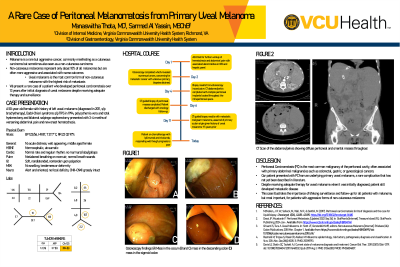Tuesday Poster Session
Category: General Endoscopy
P4147 - A Rare Case of Peritoneal Carcinomatosis From Primary Uveal Melanoma
Tuesday, October 29, 2024
10:30 AM - 4:00 PM ET
Location: Exhibit Hall E

- MT
Manaswitha Thota, MD
Virginia Commonwealth University Medical Center
Richmond, VA
Presenting Author(s)
Manaswitha Thota, MD, Sarmed Al Yassin, MBChB
Virginia Commonwealth University Medical Center, Richmond, VA
Introduction: Melanoma, an aggressive cancer that arises from melanocytes, can be subdivided into cutaneous and non-cutaneous forms. While non-cutaneous melanoma accounts for only about 10% of all melanomas, it is often more aggressive and associated with worse outcomes. Uveal melanoma, the most common form of non-cutaneous melanoma, carries the highest risk of metastasis, with up to 50% of patients developing metastases within five to seven years after treatment of the primary site. We present a rare case of a patient who developed peritoneal carcinomatosis (PC) over 13 years after initial diagnosis of uveal melanoma despite receiving adequate therapy and surveillance.
Case Description/Methods: A 50-year-old female with history of left uveal melanoma (diagnosed in 2011, status post [s/p] brachytherapy), Budd-Chiari syndrome s/p TIPS in 1994, polycythemia vera and total hysterectomy and bilateral salpingo-oophorectomy presented with 3-4 months of worsening abdominal pain and new onset hematochezia. Lab work notable for acute blood loss anemia, thrombocytopenia, transaminases at the upper limit of normal, elevated alkaline phosphatase to 139 U/L, and unremarkable tumor markers. Given hematochezia and acute blood loss anemia, a colonoscopy was completed which was notable for submucosal masses found throughout the cecum, sigmoid, and descending colon, with follow-up biopsies negative for malignancy. To investigate further, a CT abdomen/pelvis was obtained which revealed extensive peritoneal and omental masses, concerning for PC. Ultimately, patient had a CT guided core needle biopsy of a left lower quadrant pelvic mass which revealed metastatic malignant melanoma, likely from previous uveal melanoma. While the prognosis is poor, the patient is currently receiving combination chemotherapy with Ipilimumab and Nivolumab with good response.
Discussion: PC, the most common malignancy of the peritoneal cavity, is commonly associated with primary abdominal malignancies such as colorectal, gastric, and/or gynecological cancers. Our patient presented with PC from an underlying primary uveal melanoma, a rare complication that has not yet been described in literature. Despite receiving adequate therapy for uveal melanoma when it was initially diagnosed, patient still developed metastatic disease to the peritoneal cavity, illustrating the importance of lifelong surveillance and follow-up for all patients with melanoma, but most importantly, for patients with aggressive forms of non-cutaneous melanoma.
Disclosures:
Manaswitha Thota, MD, Sarmed Al Yassin, MBChB. P4147 - A Rare Case of Peritoneal Carcinomatosis From Primary Uveal Melanoma, ACG 2024 Annual Scientific Meeting Abstracts. Philadelphia, PA: American College of Gastroenterology.
Virginia Commonwealth University Medical Center, Richmond, VA
Introduction: Melanoma, an aggressive cancer that arises from melanocytes, can be subdivided into cutaneous and non-cutaneous forms. While non-cutaneous melanoma accounts for only about 10% of all melanomas, it is often more aggressive and associated with worse outcomes. Uveal melanoma, the most common form of non-cutaneous melanoma, carries the highest risk of metastasis, with up to 50% of patients developing metastases within five to seven years after treatment of the primary site. We present a rare case of a patient who developed peritoneal carcinomatosis (PC) over 13 years after initial diagnosis of uveal melanoma despite receiving adequate therapy and surveillance.
Case Description/Methods: A 50-year-old female with history of left uveal melanoma (diagnosed in 2011, status post [s/p] brachytherapy), Budd-Chiari syndrome s/p TIPS in 1994, polycythemia vera and total hysterectomy and bilateral salpingo-oophorectomy presented with 3-4 months of worsening abdominal pain and new onset hematochezia. Lab work notable for acute blood loss anemia, thrombocytopenia, transaminases at the upper limit of normal, elevated alkaline phosphatase to 139 U/L, and unremarkable tumor markers. Given hematochezia and acute blood loss anemia, a colonoscopy was completed which was notable for submucosal masses found throughout the cecum, sigmoid, and descending colon, with follow-up biopsies negative for malignancy. To investigate further, a CT abdomen/pelvis was obtained which revealed extensive peritoneal and omental masses, concerning for PC. Ultimately, patient had a CT guided core needle biopsy of a left lower quadrant pelvic mass which revealed metastatic malignant melanoma, likely from previous uveal melanoma. While the prognosis is poor, the patient is currently receiving combination chemotherapy with Ipilimumab and Nivolumab with good response.
Discussion: PC, the most common malignancy of the peritoneal cavity, is commonly associated with primary abdominal malignancies such as colorectal, gastric, and/or gynecological cancers. Our patient presented with PC from an underlying primary uveal melanoma, a rare complication that has not yet been described in literature. Despite receiving adequate therapy for uveal melanoma when it was initially diagnosed, patient still developed metastatic disease to the peritoneal cavity, illustrating the importance of lifelong surveillance and follow-up for all patients with melanoma, but most importantly, for patients with aggressive forms of non-cutaneous melanoma.
Disclosures:
Manaswitha Thota indicated no relevant financial relationships.
Sarmed Al Yassin indicated no relevant financial relationships.
Manaswitha Thota, MD, Sarmed Al Yassin, MBChB. P4147 - A Rare Case of Peritoneal Carcinomatosis From Primary Uveal Melanoma, ACG 2024 Annual Scientific Meeting Abstracts. Philadelphia, PA: American College of Gastroenterology.
